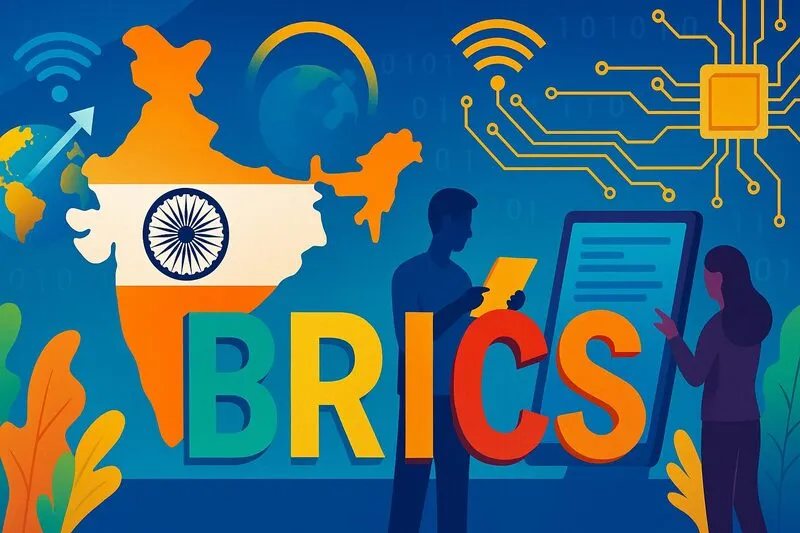India has taken a leading role in BRICS digital innovation, hosting a Virtual Capacity Building Session on Digital Transformation that brought together digital leaders from across BRICS nations. The Department of Telecommunications (DoT), through the National Communications Academy – Technology (NCA-T) in Ghaziabad, organized this strategic gathering under the BRICS ICT Working Group framework.
This initiative demonstrates how BRICS digital transformation efforts are being accelerated through collaborative knowledge sharing and the implementation of citizen-centric digital services across member countries. The session also highlighted digital public infrastructure BRICS capabilities and emerging technology BRICS collaboration opportunities.
Also Read: India Urges BRICS Digital Pact, Raising Alarm Bells for US Hegemony
India’s Role in BRICS Digital Transformation and Emerging Technologies

The capacity building session brought together digital leaders from across BRICS nations to explore shared challenges and also best practices. The event focused on mobile security, cyber resilience, digital infrastructure, and digital twin technologies as key areas for India’s BRICS digital innovation cooperation.
Daniel Cavalcanti, BRICS Chair, emphasized the importance of the session in advancing cooperation across multiple areas including mobile security, cyber resilience, digital infrastructure, and digital twin technologies.
Atul Sinha, Director General of NCA-T, India, highlighted the collaborative approach:
“capacity building through collaboration, co-creating scalable, secure technologies, and fostering partnerships to empower citizens across BRICS nations”
Mobile Security Through Sanchar Saathi Initiative
India showcased its flagship Sanchar Saathi initiative as a model for BRICS digital transformation in mobile security. This program focuses on citizen-centric digital services that protect users from fraud while enhancing transparency and ensuring equitable access to mobile services. The initiative demonstrates how digital public infrastructure BRICS nations can implement regulatory frameworks that foster trust and also inclusivity.
The session emphasized citizen-centric regulatory frameworks that address mobile security concerns across BRICS nations, with India’s approach serving as a blueprint for other member countries. At the time of writing, this initiative continues to serve as a model for protecting citizens from digital fraud.
Cyber Resilience and Cross-Border Cooperation
The second thematic session featured presentations from India and Brazil on national approaches to cyber resilience. Both countries emphasized preparedness, rapid response, and also cross-border cooperation to counter cyber threats. This emerging technology BRICS collaboration demonstrates how shared intelligence and cooperative frameworks can strengthen cyber defense capabilities right now.
The discussions revealed how India’s BRICS digital innovation extends to cyber security, with member nations working together to build robust defense mechanisms against sophisticated attacks. The collaborative approach has been designed to address the growing complexity of cyber threats.
AADHAAR as Digital Public Infrastructure Foundation
AADHAAR is one of the new core systems of the digital MRICS building blocks that India has contributed to digital inclusion via identity-based public service delivery methods. The Chinese experience on the road to digital infrastructure also gave insights, including the aspects of secure, inclusive, and interoperable platforms.
The session was dedicated to the creation of citizen-centric digital services that can guarantee positive outcomes of digital transformation of BRICS to the citizens irrespective of their economic and social statuses. AADHAAR is a revolutionary device of governance effectiveness, outreach of services in India.
Sangam Digital Twin Initiative
India also launched its large-scale Sangam Digital Twin project, including AI-native, federated systems of scenario-based infrastructure planning and real-time solutions to the governing-related problems. China presented its Digital Twin experiences and showed predictive simulations and prospects of data-driven governance.
The Digital Twin sessions explored how the emerging technology of BRICS collaboration can change the method of handling public infrastructure management since the governments can experiment as well as optimize resources before actualization. This represents a major development in the predictive governance abilities.
Also Read: India Reveals New Details About BRICS Currency
Future Strategic Alliances
Deputy Director General, International Relations Division, DoT, India, Avinash Agarwal and BRICS Chair Daniel Cavalcanti reinstated the statements of BRICS countries in regard to learning and joint digital development.
The meetings laid down the steps of exchanging good practice examples, finding up-scalable innovations, and establishing the personnel in further digital collaboration. Such consequences should provide a boost to strategic relationships and robust digital communities in the BRICS states and develop the Indian BRICS digital innovation through pivotal collaboration and collective technological skills.






